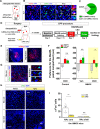Modulation of methamphetamine memory reconsolidation by neural projection from basolateral amygdala to nucleus accumbens
- PMID: 36109595
- PMCID: PMC9852248
- DOI: 10.1038/s41386-022-01417-y
Modulation of methamphetamine memory reconsolidation by neural projection from basolateral amygdala to nucleus accumbens
Abstract
Drug-associated conditioned cues promote subjects to recall drug reward memory, resulting in drug-seeking and reinstatement. A consolidated memory becomes unstable after recall, such that the amnestic agent can disrupt the memory during the reconsolidation stage, which implicates a potential therapeutic strategy for weakening maladaptive memories. The basolateral amygdala (BLA) involves the association of conditioned cues with reward and aversive valences and projects the information to the nucleus accumbens (NAc) that mediates reward-seeking. However, whether the BLA-NAc projection plays a role in drug-associated memory reactivation and reconsolidation is unknown. We used methamphetamine (MeAM) conditioned place preference (CPP) to investigate the role of BLA-NAc neural projection in the memory reconsolidation. Two weeks before CPP training, we infused adeno-associated virus (AAV) carrying the designer receptor exclusively activated by designer drugs (DREADD) or control constructs. We infused clozapine-N-oxide (CNO) after the recall test to manipulate the neural activity of BLA-NAc projections in mice. We found that after recall, DREADD-mediated inhibition of BLA neurons projecting to the NAc core blunted consolidated MeAM-associated memory. Inhibition of BLA glutamatergic nerve terminals in the NAc core 1 h after recall disrupted consolidated MeAM-associated memory. However, inhibiting this pathway after the time window of reconsolidation failed to affect memory. Furthermore, under the condition without memory retrieval, DREADD-mediated activation of BLA-NAc core projection was required for amnesic agents to disrupt consolidated MeAM-associated memory. Our findings provide evidence that the BLA-NAc pathway activity is involved in the post-retrieval processing of MeAM-associated memory in CPP.
© 2022. The Author(s), under exclusive licence to American College of Neuropsychopharmacology.
Conflict of interest statement
The authors declare no competing interests.
Figures





Similar articles
-
AMPA receptor endocytosis in the amygdala is involved in the disrupted reconsolidation of Methamphetamine-associated contextual memory.Neurobiol Learn Mem. 2013 Jul;103:72-81. doi: 10.1016/j.nlm.2013.04.004. Epub 2013 Apr 17. Neurobiol Learn Mem. 2013. PMID: 23603364
-
Region-specific role of Rac in nucleus accumbens core and basolateral amygdala in consolidation and reconsolidation of cocaine-associated cue memory in rats.Psychopharmacology (Berl). 2013 Aug;228(3):427-37. doi: 10.1007/s00213-013-3050-8. Epub 2013 Mar 15. Psychopharmacology (Berl). 2013. PMID: 23494234
-
Pathway-specific regulation of amphetamine-induced conditioned place preference by chemogenetic modulation of basolateral amygdala projections to prelimbic cortex and nucleus accumbens subregions.Neurochem Int. 2025 Sep;188:106012. doi: 10.1016/j.neuint.2025.106012. Epub 2025 Jun 18. Neurochem Int. 2025. PMID: 40541740
-
Basolateral amygdala and stress-induced hyperexcitability affect motivated behaviors and addiction.Transl Psychiatry. 2017 Aug 8;7(8):e1194. doi: 10.1038/tp.2017.161. Transl Psychiatry. 2017. PMID: 28786979 Free PMC article. Review.
-
Targeting drug memory reconsolidation: a neural analysis.Curr Opin Pharmacol. 2021 Feb;56:7-12. doi: 10.1016/j.coph.2020.08.007. Epub 2020 Sep 19. Curr Opin Pharmacol. 2021. PMID: 32961367 Review.
Cited by
-
Greater fatigue, disturbed sleep, persistent memory problems, and reduced CD4+ T cell and B cell percentages in adults with a history of methamphetamine dependence.J Neuroimmunol. 2025 May 15;402:578567. doi: 10.1016/j.jneuroim.2025.578567. Epub 2025 Feb 25. J Neuroimmunol. 2025. PMID: 40088605
-
Cell-type specific epigenetic and transcriptional mechanisms in substance use disorder.Front Cell Neurosci. 2025 Mar 28;19:1552032. doi: 10.3389/fncel.2025.1552032. eCollection 2025. Front Cell Neurosci. 2025. PMID: 40226298 Free PMC article. Review.
-
Dorsal raphe to basolateral amygdala corticotropin-releasing factor circuit regulates cocaine-memory reconsolidation.Neuropsychopharmacology. 2024 Dec;49(13):2077-2086. doi: 10.1038/s41386-024-01892-5. Epub 2024 May 27. Neuropsychopharmacology. 2024. PMID: 38802479
-
Dorsal Raphe to Basolateral Amygdala Corticotropin-Releasing Factor Circuit Regulates Cocaine-Memory Reconsolidation.bioRxiv [Preprint]. 2024 Feb 12:2024.02.10.579725. doi: 10.1101/2024.02.10.579725. bioRxiv. 2024. Update in: Neuropsychopharmacology. 2024 Dec;49(13):2077-2086. doi: 10.1038/s41386-024-01892-5. PMID: 38405858 Free PMC article. Updated. Preprint.
-
Restoring GABAB receptor expression in the ventral tegmental area of methamphetamine addicted mice inhibits locomotor sensitization and drug seeking behavior.Front Mol Neurosci. 2024 Feb 7;17:1347228. doi: 10.3389/fnmol.2024.1347228. eCollection 2024. Front Mol Neurosci. 2024. PMID: 38384279 Free PMC article.
References
-
- Sampedro-Piquero P, Ladrón de Guevara-Miranda D, Pavón FJ, Serrano A, Suárez J, Rodríguez de Fonseca F, et al. Neuroplastic and cognitive impairment in substance use disorders: a therapeutic potential of cognitive stimulation. Neurosci Biobehav Rev. 2019;106:23–48. doi: 10.1016/j.neubiorev.2018.11.015. - DOI - PubMed
-
- Bossert JM, Poles GC, Wihbey KA, Koya E, Shaham Y. Differential effects of blockade of dopamine D1-family receptors in nucleus accumbens core or shell on reinstatement of heroin seeking induced by contextual and discrete cues. J Neurosci. 2007;27:12655–63. doi: 10.1523/jneurosci.3926-07.2007. - DOI - PMC - PubMed
Publication types
MeSH terms
Substances
LinkOut - more resources
Full Text Sources
Medical

